How to make the right chimney for a potbelly stove with your own hands: step-by-step instructions
A potbelly stove is often used to heat temporary buildings, garages, greenhouses, and utility rooms.But it also emits combustion products, a lot of smoke from burned wood or other fuels.
Therefore, you will need to decide how to make a chimney for a potbelly stove and where it is best to install it so that it is inexpensive and effective. Moreover, you can do it yourself. Moreover, everything is not as complicated as it might seem at first glance.
To make it easier for you to understand the assembly and installation of the chimney, in this article we looked at the step-by-step process, starting with the selection of material and assembly and ending with checking the functionality of the already installed system.
The content of the article:
What can a chimney be made from?
To use a potbelly stove, you will need to take care of smoke removal. To do this, you have to build a chimney, selecting the optimal material.
You can invite specialists to carry out the work, or you can do everything on your own, especially since the amount of work is small.
Types of chimney pipes
Various materials are used to make smoke exhaust pipes.
Initially, depending on the material of manufacture, there are 2 options:
- Take ready-made pipes made at the factory;
- Make pipes from stainless steel sheets or other sheet metal.
The cheapest way is to make your own pipes. The undoubted advantage here is that the pipe will be of the required diameter, which is especially important for homemade potbelly stoves.
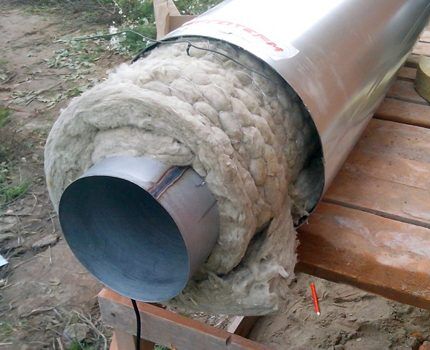
The second advantage of homemade pipes is cost. To make them, you can use improvised material, or purchase metal sheets with a thickness of 0.6 mm. Or better yet, 1 mm.
Moreover, you can also make an insulated chimney pipe by making 2 pipes of different diameters from sheets. Or take ready-made metal ones of different diameters. In addition to making chimney pipes yourself, you can opt for a simpler and faster option - buy ready-made pipes from the required material.
An elementary option for assembling a chimney for a potbelly stove involves the use of ready-made steel pipes and a corner element. A smoke channel is assembled from them and welded to a homemade stove:
The most common materials are:
- Brick. This is the cheapest material. A chimney is laid out of it on site, but this will require skill;
- Steel. Stainless steel, galvanized, alloy (carbon) pipe can be used as a smoke exhaust;
- Ceramics. Ceramic products are highly expensive, which eliminates installation ceramic chimney in the garage or utility room;
- Asbestos cement. Asbestos-cement products are affordable, but are not suitable as a material for constructing a chimney. Although they can often be seen in this role;
- Vermiculite. These pipes are made of stainless steel with a 5-centimeter layer of vermiculite applied to the inner surface of the pipe.
In addition to these options, the market offers many other products. Thus, you can find pipes made of heat-resistant glass, from which it is quite possible to build an exotic chimney. But this is done extremely rarely - skill is required to install and connect individual structural elements to each other.
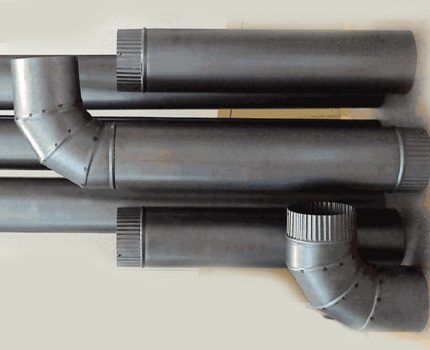
Recommendations for choosing a pipe for a potbelly stove
To make a chimney for a potbelly stove, it is not necessary to construct pipes from metal sheets with your own hands. This will require some skill and time.
After all, the sheets will first need to be rolled into a tube of the required diameter, and then the seam must be tightly secured using rivets and heat-resistant sealant. It is much easier and faster to buy the necessary products produced at the factory.
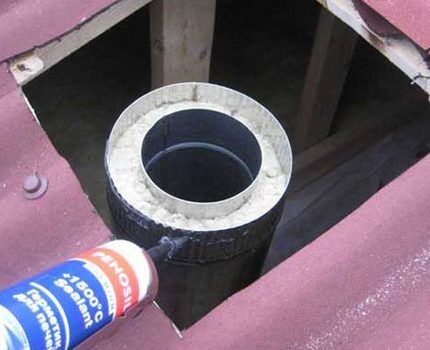
As for the material, it is not worth taking cheap asbestos-cement pipes for these purposes - this material will not withstand if the temperature during the combustion process rises above 300 degrees Celsius. And the pipe itself is quite heavy.
It will also absorb condensation. But making a hole to clean out soot or remove condensation will be problematic.
Making a chimney for a potbelly stove out of brick is an unreasonably high expense. Firstly, rarely do any home craftsmen know how to do proper masonry. And secondly, this is a bulky structure that requires additional strengthening of the foundation. A potbelly stove is a temporary heating equipment.
A metallized corrugation can serve as a temporary replacement for a stationary metal pipe, but for permanent use it must be replaced with a metal pipe:
It is optimal to take metal pipes made of stainless steel, or better yet, alloy steel. A structure made of such material can serve as a chimney for 7-10 years. This is provided that the pipes are of sufficient thickness - 6-10 mm or more. And the quality of assembly of all elements of the smoke exhaust system plays an important role.
Another undoubted advantage of metal pipes is their lightness. The light weight allows you to carry out all the work on constructing a chimney for a potbelly stove alone.
We also recommend that you familiarize yourself with more complete information on choosing a chimney pipe.
Having decided on the material for the future chimney, you can begin purchasing all the components and constructing a correct and functional design.
Instruction on chimney construction
The complexity of constructing a chimney for a potbelly stove depends on where exactly the stove will be installed. After all, cutting a hole in the roof is more difficult than threading a pipe through a window.
Therefore, the labor intensity and time of manufacturing the correct chimney for a potbelly stove depends entirely on the individual characteristics of a particular household.
Stage #1 - chimney assembly
The simplest option for constructing a chimney is if the potbelly stove is to be used outdoors. Here it is important to choose the optimal place to install the stove so that flammable objects do not come into contact with it. And the pipes themselves must be heat-resistant.
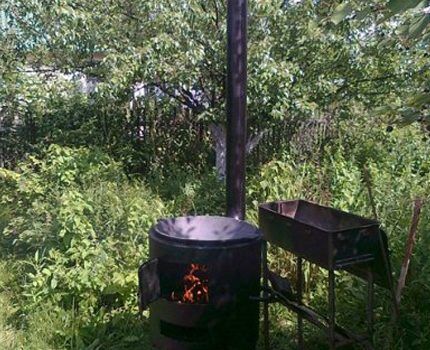
If the smoke removal pipeline is built indoors, then you need to follow a number of safety rules that will help protect yourself and your loved ones from fire.
Firstly, the pipes must withstand high temperatures - preferably 1000 degrees Celsius and above. After all, the smoke released during the combustion of fuel in a potbelly stove can have a fairly high temperature.
Secondly, it is important to position the stove itself so that it does not come into contact with surfaces that could catch fire. If the walls are lined with clapboard or plastic, then additional work needs to be done to protect yourself from a fire hazard.

Thirdly, the place where the pipe enters the ceiling or wall must be properly designed.
To do this, it is important to maintain a distance from nearby objects and walls - during operation of the stove, the temperature of the pipe will increase and objects located nearby may burst into flames.
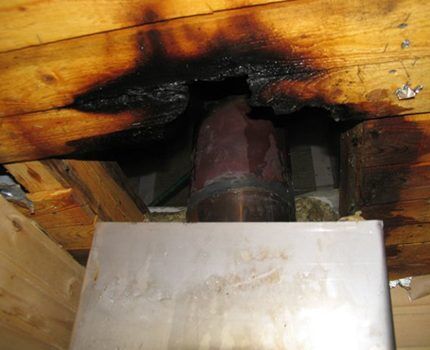
Fourthly, only one potbelly stove can be connected to one chimney. For the second stove in the next room, it is better to lay a separate pipeline for smoke removal.
Stage #2 - taking measurements
At the preparatory stage, it is necessary to determine the required diameter of the pipes and their total length. First you need to calculate the diameter of the pipe. Correctly, if it is 2.7 times larger than the volume of the combustion chamber.
So, if the potbelly stove is 50 liters, then the chimney diameter should be: 50 * 2.7 = 135 mm. So, if you take a pipe with a diameter of 100 mm, it will not cope with the smoke emitted. As a result, there will be weak draft and it is useless to expect effective operation from such a stove.
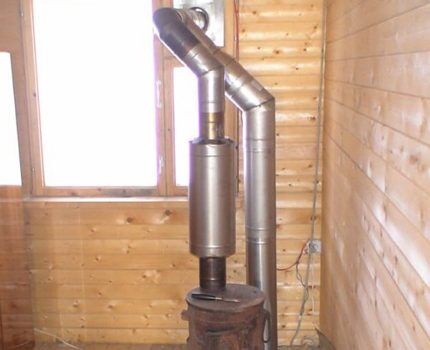
In addition, the length of the future smoke removal pipeline will have to be measured. To do this, it is important to choose a permanent location for the potbelly stove indoors.
Then determine where the pipe will go outside. An important point is that during the process of removing smoke, condensation will accumulate in a chimney running outside. It is worth taking care to remove it.
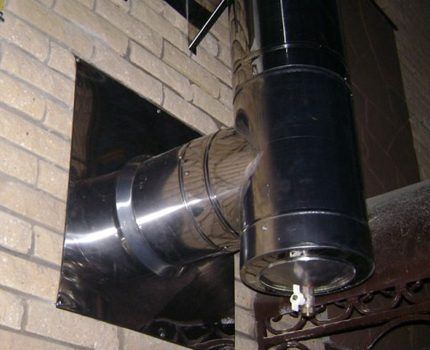
Now you have to measure the distance of the pipeline on the street and do not forget that the chimney will rise, on average, 1.5 meters above the roof ridge.
It should also be noted that during the installation process you will need elbows, tees, a pass-through glass, butt elbows, heat-resistant sealant, asbestos cord, pipes of the required diameter, pipe clamps or welding to connect all components into a single chimney structure.
All this must be purchased on time, when all measurements have been taken. Having the necessary materials will allow you to begin the installation of a chimney for a potbelly stove.
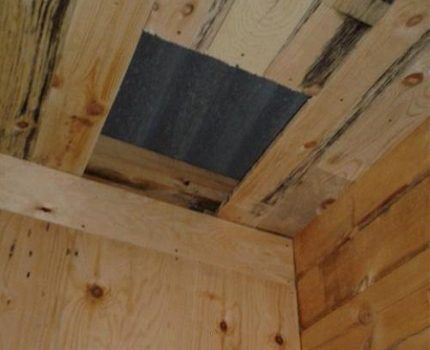
It is still necessary to decide in advance where exactly the pipe will go out onto the street:
- through the window;
- through the wall;
- through the ceiling.
This will determine where the hole is to be made. Most often, the pipe is run through a wall or ceiling. To ensure safety in this place, you will have to buy a special passage unit - a glass. It is made of heat-resistant material that will protect against fire.
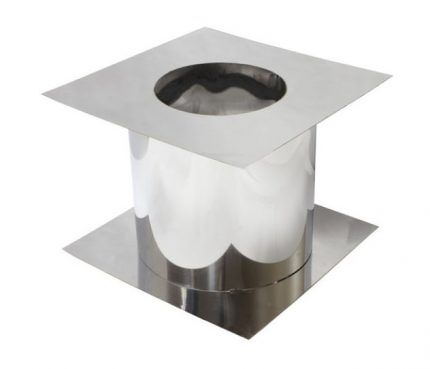
Stage #3 - installation of all components of the structure
When it comes to a potbelly stove that operates outdoors, it is important to take a pipe of the required diameter that corresponds to the pipe extending from the potbelly stove.
The chimney pipe must be put on the pipe. This is important, because if it is inserted into the pipe, smoke may leak out at the junction. There is no need to install anything else - the potbelly stove can be used for cooking or heating food.
If we are talking about installing a chimney in a utility room, garage or greenhouse, then the procedure for carrying out the work will be more complicated. First you need to take a piece of pipe and carefully fix it on the chimney opening/pipe of the potbelly stove. It is important to place the pipe on this pipe.
Then you have to lengthen the pipeline using an elbow. The goal is to reach the wall/ceiling. A passage glass is already waiting here, through which the chimney will pass.
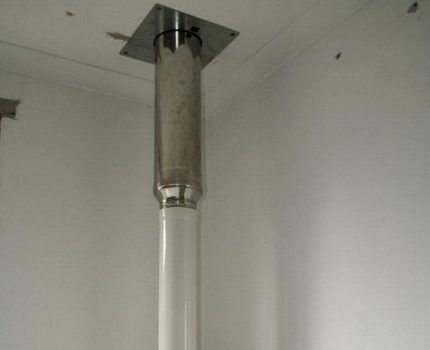
Next, the pipeline goes into the under-roof space and onto the roof or through the wall to the street. It is important here that the street pipe is insulated. Also, when the pipe goes outside, it is necessary to provide condensate drainage. To do this, install a tee and make an inspection window to simplify cleaning the chimney.
It is important to securely fix all connections and maintain a distance from walls and other objects that can easily catch fire.
Using a flash wizard to arrange and seal the passage of a chimney through the roof greatly facilitates and speeds up the work:
Stage #4 - system check
When all the components of the chimney are assembled and firmly connected to each other, you can proceed to the final stage - installing the cap and checking the functionality of the structure.
So, sparks can fly out of a potbelly stove during the combustion of fuel.
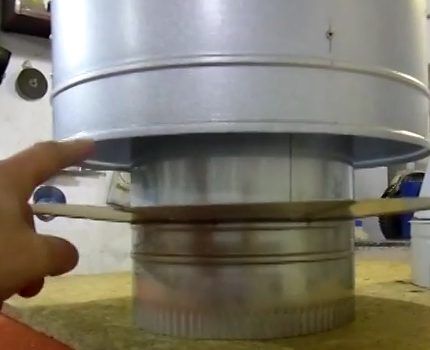
As spark arrester You can use a mesh with small cells, the size of which is up to 5 mm. This is especially true if the roof or nearby structures are made of flammable materials.
If there is no danger of a fire, then you can get by with a simple cap, which is put on the end of the chimney and fixed there with a clamp or carefully secured with rivets.
To increase traction, you can use a deflector by choosing one of the options on the market, or assembling it yourself. We invite you to read the detailed instructions for making your own chimney deflector.
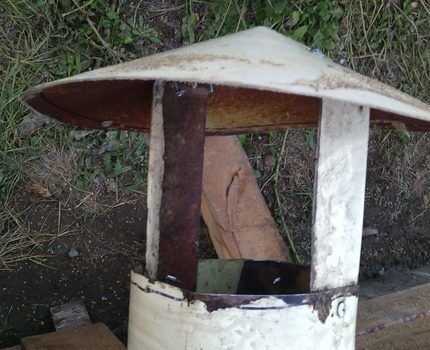
When the cap is installed, you can begin to check the functionality of the entire chimney structure. To do this, you need to load the fuel, set it on fire and see how it burns and how the smoke goes away.
If it starts to leak through any connection, it means it is not sealed. This problem will need to be corrected using heat resistant sealant or welding.
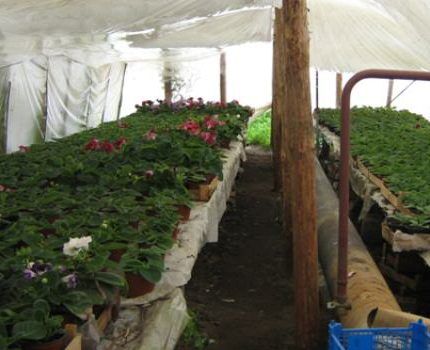
Features of chimney maintenance
The chimney of a potbelly stove needs maintenance - inspection of the external condition of the structure and cleaning of the internal space of the pipe.The frequency of maintenance depends entirely on the material.
If it is an asbestos-cement chimney, then it will have to be cleaned more often. This is all due to the rough inner surface of the pipe, where soot accumulates with a vengeance.
Also, an asbestos chimney, if it was installed to remove smoke from a potbelly stove, may soon become stained or even rupture during operation. This will lead to additional expenses - the chimney pipe will need to be replaced.
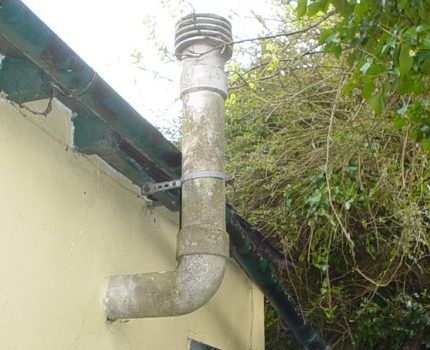
For a metal chimney, the average frequency of pipe cleaning is once a year. It is also important to inspect the external condition of the material - it is quite possible that some areas may burn out.
To remove soot from a metal pipe, you can:
- burn aspen wood;
- treat the burned logs with a special chemical composition that is easy to buy;
- make a hook for delicate soot removal.
Compositions for getting rid of soot are easy to use. They do not require any special skills - just treat the firewood with the product from the bag and light the potbelly stove as usual. Combustion products will not contain harmful impurities. This is a safe way to clean a metal pipe.

In a metal pipe that exhausts smoke, soot most often accumulates in a section that runs horizontally.
Experienced users of such chimneys have found a convenient solution - drill a small hole and build a hook-shaped structure to remove soot. This device will not damage the pipe wall, but will clear the accumulated fumes.
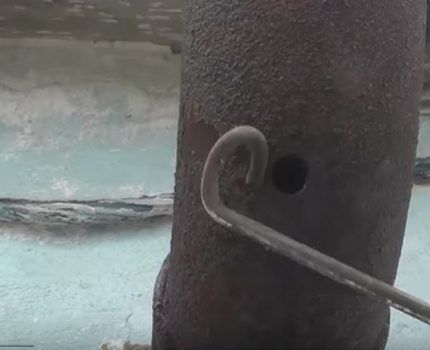
A thorough inspection of the external condition of the chimney will allow you to timely diagnose the need to replace a particular section. This measure should not be neglected - after all, through the holes in the chimney, smoke will flow into the room, and further operation of the heating device will become impossible.
Regular cleaning of soot from the internal walls will help extend the life of the smoke exhaust pipe. And the draft will always be at the required level, which has a positive effect on the efficiency of the potbelly stove.
There are also other articles on our website that contain detailed information about the best methods for cleaning a chimney and recommendations for choosing a cleaning product. We invite you to familiarize yourself with them:
- How to clean a chimney from soot: how to properly clean a smoke duct
- Chimney cleaning products: what is the best way to clean a chimney from soot
- Chimney Sweeper log for cleaning chimneys: composition of the product and instructions for use + reviews from owners
Conclusions and useful video on the topic
The subtleties of self-assembly of a chimney structure are shown in the video clip:
If the draft in the chimney is too strong, you can build a device to regulate it. How to do this is shown in the video:
Inexperienced craftsmen often make mistakes when installing a chimney. This video explains the most common problems:
If there is a problem with smoke escaping into the room, it can be quickly and easily solved. The video demonstrates how to do this:
To maintain the metal chimney of a potbelly stove, you can use a simple method of delicate physical cleaning:
Making a chimney for a potbelly stove is not difficult if you approach the task responsibly and do everything correctly. Only in this case will the compact stove serve for a long time, without requiring additional attention..
And the quality of its work will constantly please you, the main thing is to promptly clean the chimney from soot and other combustion products.
Do you use a potbelly stove equipped with a homemade chimney? Share your assembly experience and photos of the finished chimney in the comments section. Tell us what material you used for the chimney pipe and how difficult the task of making the chimney was for you.




Up to the roof you need to take a stainless steel pipe 1 mm thick with a high-quality weld so that it does not burn out in a month, because the outlet temperatures are quite high. Next, so that all the heat is not carried out, as they say, into the chimney, you need to insulate the outer chimney. Well, here you can either insulate it yourself or buy an insulated one - although this pleasure is not cheap. It’s also better not to skimp on the height of the chimney, because the draft depends on this height. The material of the chimney pipe (the one on the street) is also preferably stainless steel, 0.5 mm is possible, the main thing is not galvanized. Many people install asbestos pipes. But I think metal is better.
As for the brick chimney, it is the cheapest, most reliable and durable, unlike the metal one, which becomes overgrown with soot and resin very quickly. If we are talking about an asbestos pipe, then it can only be placed at the passage through the roof where the smoke has a temperature below 200 degrees, otherwise it will explode from heating.
A chimney made of stainless steel with a thickness of 0.5 mm is used only for gas heating, since the temperature of the exhaust gases is approximately 110 degrees, and for stoves at the outlet of the furnace gate it can be above 350 degrees. Therefore, the thickness of the stainless pipe should be at least 0.8 mm and preferably 1 mm, and then you can go a meter to 0.8 mm and put a sandwich through the ceiling.
Potbelly stoves are now the domain of garages and some outbuildings. There are exceptions, but they are rare. Have you often seen brick chimneys in garages? It is more important that it is collapsible, which greatly facilitates cleaning, which is periodically necessary. So metal is best.